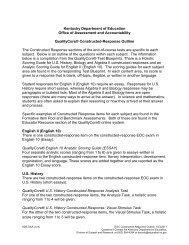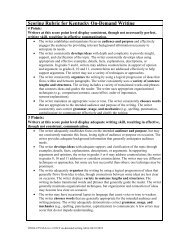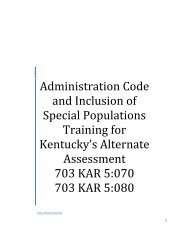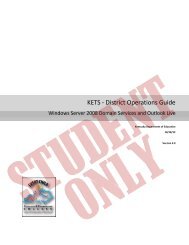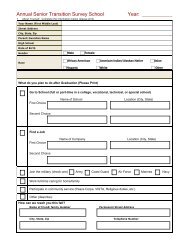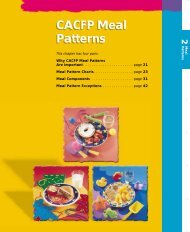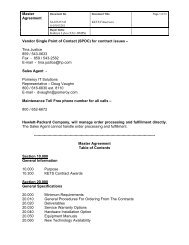Standards with Progressions grades K-HS v. 1.3 - Kentucky ...
Standards with Progressions grades K-HS v. 1.3 - Kentucky ...
Standards with Progressions grades K-HS v. 1.3 - Kentucky ...
- No tags were found...
Create successful ePaper yourself
Turn your PDF publications into a flip-book with our unique Google optimized e-Paper software.
Seeing Structure in Expressions A-SSE<br />
Interpret the structure of expressions<br />
1. Interpret expressions that represent a quantity in terms of its context.★<br />
a. Interpret parts of an expression, such as terms, factors, and coefficients.<br />
b. Interpret complicated expressions by viewing one or more of their parts as a single entity. For<br />
example, interpret P(1+r)n as the product of P and a factor not depending on P.<br />
2. Use the structure of an expression to identify ways to rewrite it. For example, see x4 – y4 as<br />
(x2)2 – (y2)2, thus recognizing it as a difference of squares that can be factored as (x2 – y2)(x2 +<br />
y2).<br />
Write expressions in equivalent forms to solve problems<br />
3. Choose and produce an equivalent form of an expression to reveal and explain properties of the<br />
quantity represented by the expression.★<br />
a. Factor a quadratic expression to reveal the zeros of the function it defines.<br />
b. Complete the square in a quadratic expression to reveal themaximum or minimum value of the<br />
function it defines.<br />
c. Use the properties of exponents to transform expressions for exponential functions. For example<br />
the expression 1.15t can be rewritten as (1.151/12)12t ≈ 1.01212t to reveal the approximate<br />
equivalent monthly interest rate if the annual rate is 15%.<br />
4. Derive the formula for the sum of a finite geometric series (when the common ratio is not 1), and<br />
use the formula to solve problems. For example, calculate mortgage payments.★<br />
Arithmetic <strong>with</strong> Polynomials and Rational Expressions A -APR<br />
Perform arithmetic operations on polynomials<br />
1. Understand that polynomials form a system analogous to the integers, namely, they are closed<br />
under the operations of addition, subtraction, and multiplication; add, subtract, and multiply<br />
polynomials.<br />
Understand the relationship between zeros and factors of polynomials<br />
2. Know and apply the Remainder Theorem: For a polynomial p (x) and a number a, the remainder<br />
on division by x – a is p(a), so p(a) = 0 if and only if (x – a) is a factor of p(x).<br />
3. Identify zeros of polynomials when suitable factorizations are available, and use the zeros to<br />
construct a rough graph of the function defined by the polynomial.<br />
Use polynomial identities to solve problems<br />
4. Prove polynomial identities and use them to describe numerical relationships. For example, the<br />
polynomial identity (x2 + y2)2 = (x2 – y2)2 +(2xy)2 can be used to generate Pythagorean triples.<br />
5. (+) Know and apply the Binomial Theorem for the expansion of (x + y)n in powers of x and y for<br />
a positive integer n, where x and y are any numbers, <strong>with</strong> coefficients determined for example by<br />
Pascal’s Triangle.1<br />
Rewrite rational expressions<br />
6. Rewrite simple rational expressions in different forms; write a(x)/b(x) in the form q(x) + r(x)/b(x),<br />
where a(x), b(x), q(x), and r(x) are polynomials <strong>with</strong> the degree of r(x) less than the degree of b(x),<br />
using inspection, long division, or, for the more complicated examples, a<br />
computer algebra system.<br />
7. (+) Understand that rational expressions form a system analogous to the rational numbers,<br />
closed under addition, subtraction, multiplication, and division by a nonzero rational expression;<br />
add, subtract, multiply, and divide rational expressions.<br />
Creating Equations★A -CED<br />
Create equations that describe numbers or relationships<br />
1. Create equations and inequalities in one variable and use them to solve problems. Include<br />
equations arising from linear and quadratic functions, and simple rational and exponential<br />
functions.<br />
2. Create equations in two or more variables to represent relationships between quantities; graph<br />
equations on coordinate axes <strong>with</strong> labels and scales.<br />
3. Represent constraints by equations or inequalities, and by systems of equations and/or<br />
inequalities, and interpret solutions as viable or nonviable options in a modeling context. For<br />
example, represent inequalities describing nutritional and cost constraints on combinations of<br />
different foods.<br />
4. Rearrange formulas to highlight a quantity of interest, using the same reasoning as in solving<br />
equations. For example, rearrange Ohm’s law V = IR o highlight resistance R.<br />
Reasoning <strong>with</strong> Equations and Inequalities A -RE I<br />
Understand solving equations as a process of reasoning and explain the reasoning<br />
1. Explain each step in solving a simple equation as following from the equality of numbers<br />
asserted at the previous step, starting from the assumption that the original equation has a<br />
solution. Construct a viable argument to justify a solution method.<br />
2. Solve simple rational and radical equations in one variable, and give examples showing how<br />
extraneous solutions may arise.<br />
Solve equations and inequalities in one variable<br />
3. Solve linear equations and inequalities in one variable, including equations <strong>with</strong> coefficients<br />
represented by letters.<br />
4. Solve quadratic equations in one variable.<br />
a. Use the method of completing the square to transform any quadratic equation in x into an<br />
equation of the form (x – p)2 = q that has the same solutions. Derive the quadratic formula from<br />
this form.<br />
b. Solve quadratic equations by inspection (e.g., for x2 = 49), taking square roots, completing the<br />
square, the quadratic formula and factoring, as appropriate to the initial form of the equation.<br />
Recognize when the quadratic formula gives complex solutions and write them as a ± bi for real<br />
numbers a and b. (continued)<br />
Solve systems of equations<br />
5. Prove that, given a system of two equations in two variables, replacing one equation by the sum<br />
of that equation and a multiple of the other produces a system <strong>with</strong> the same solutions.<br />
6. Solve systems of linear equations exactly and approximately (e.g., <strong>with</strong> graphs), focusing on<br />
pairs of linear equations in two variables.<br />
7. Solve a simple system consisting of a linear equation and a quadratic equation in two variables<br />
algebraically and graphically. For example, find the points of intersection between the line y = –3x<br />
and the circle x2 +y2 = 3.<br />
8. (+) Represent a system of linear equations as a single matrix equation<br />
in a vector variable.<br />
9. (+) Find the inverse of a matrix if it exists and use it to solve systems of linear equations (using<br />
technology for matrices of dimension 3 × 3 or greater).<br />
Represent and solve equations and inequalities graphically<br />
10. Understand that the graph of an equation in two variables is the set of all its solutions plotted in<br />
the coordinate plane, often forming a curve (which could be a line).<br />
11. Explain why the x-coordinates of the points where the graphs of the equations y = f(x) and y =<br />
g(x) intersect are the solutions of the equation f(x) = g(x); find the solutions approximately,<br />
(continued)<br />
<strong>Kentucky</strong> Department of Education<br />
55 | P a g e




